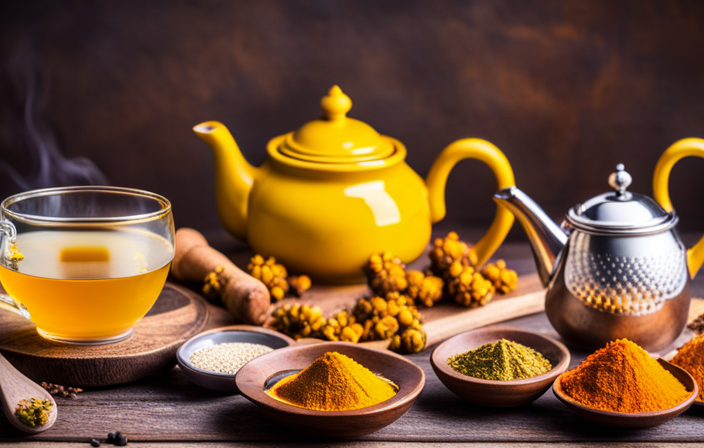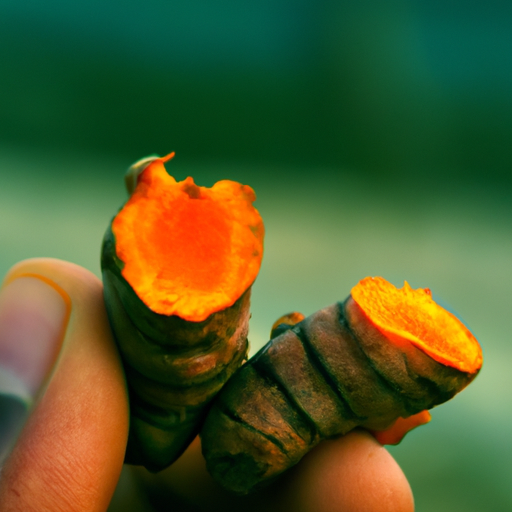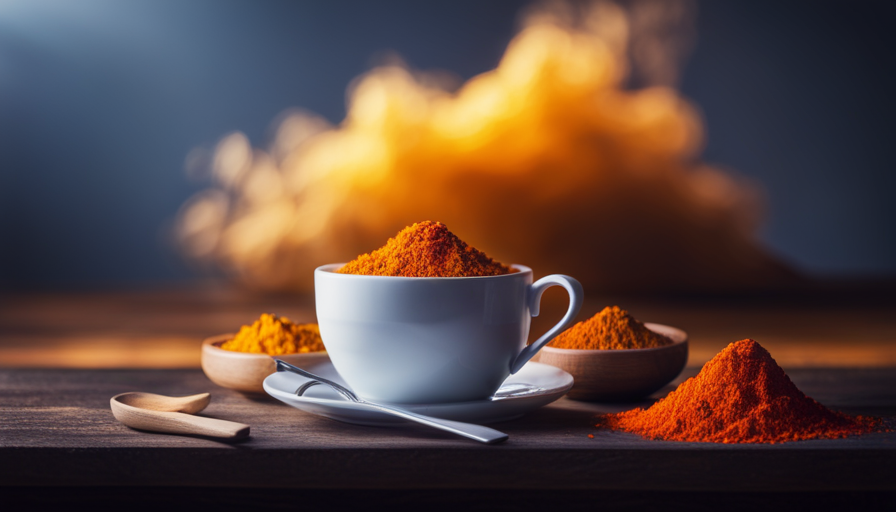Crafting the ideal mug of turmeric tea is akin to offering your taste buds a cozy hug. By following some straightforward steps, you have the ability to unleash the complete essence of this rich, golden delight, all within the cozy confines of your home.
From selecting the freshest turmeric to adding a touch of honey or lemon, I’ll guide you through the process of infusing rich flavors into every sip.
Get ready to indulge in a creamy, robust, and utterly satisfying tea experience.
Key Takeaways
- Select fresh, firm, vibrant orange turmeric roots that are free from mold or decay.
- Prefer organic turmeric to avoid exposure to pesticides or chemicals.
- Use ground turmeric as an alternative to fresh turmeric for the same health benefits.
- Enhance the flavor and absorption of turmeric tea by adding black pepper, honey, or lemon.
Selecting the Freshest Turmeric for the Best Brew
I’m selecting the freshest turmeric for the best brew.
When it comes to making turmeric tea, using fresh turmeric can provide numerous health benefits. Fresh turmeric contains a compound called curcumin, which has powerful antioxidant and anti-inflammatory properties. These properties can help reduce inflammation in the body, support a healthy immune system, and promote overall well-being.
To ensure that I’m getting the freshest turmeric, I look for roots that are firm, vibrant orange in color, and free from any signs of mold or decay. I also prefer organic turmeric to avoid any potential exposure to pesticides or chemicals.
By selecting the freshest turmeric, I can maximize the turmeric tea benefits and enjoy a delicious and nutritious beverage.
Now, let’s explore using ground turmeric as an alternative option.
Using Ground Turmeric as an Alternative Option
I can use ground turmeric as an alternative option for brewing turmeric tea. Ground turmeric offers the same health benefits as fresh turmeric, making it a convenient and accessible choice for those who may not have access to fresh turmeric root. This versatile spice can be used in a variety of turmeric recipes, including teas. To brew turmeric tea using ground turmeric, simply add a teaspoon of ground turmeric to a cup of hot water. Let it steep for about 10 minutes, then strain and enjoy. Ground turmeric is known for its anti-inflammatory and antioxidant properties, which can help boost the immune system and reduce inflammation in the body. Incorporating ground turmeric into your daily routine can be a simple and effective way to reap its many benefits.
| Ground Turmeric Benefits | Turmeric Recipes |
|---|---|
| Anti-inflammatory | Turmeric Latte |
| Antioxidant | Golden Milk |
| Immune-boosting | Turmeric Smoothie |
Enhancing Flavor With the Addition of Black Pepper
I love adding black pepper to my dishes because it enhances the flavor in a unique way.
When it comes to turmeric, black pepper is especially important.
Not only does it add a subtle heat and depth to the tea, but it also boosts the bioavailability of curcumin, the active compound in turmeric, making it easier for our bodies to absorb its health benefits.
Pepper’s Role in Flavor
Adding black pepper to my recipe enhances the flavor of the dish. But did you know that black pepper also has several health benefits and plays a significant role in traditional medicine?
Black pepper contains a compound called piperine, which has been shown to have anti-inflammatory and antioxidant properties. It can help improve digestion, increase nutrient absorption, and even potentially aid in weight loss.
In traditional medicine, black pepper has been used to treat various ailments such as colds, coughs, and respiratory disorders. Its warming properties are believed to stimulate circulation and promote sweating, which can help with detoxification.
Now, let’s explore another powerful spice that pairs well with black pepper: turmeric.
Turmeric and Black Pepper
Combining turmeric and black pepper enhances the flavor of dishes and provides numerous health benefits, making it a powerful duo in the kitchen. Turmeric, known for its vibrant yellow color, is a spice that has been used for centuries in traditional medicine. It contains a compound called curcumin, which has anti-inflammatory and antioxidant properties. Black pepper, on the other hand, contains a compound called piperine, which enhances the absorption of curcumin in the body. Together, turmeric and black pepper create a synergistic effect, maximizing their health benefits. One popular way to incorporate these two spices into your diet is by brewing turmeric tea. Here are a few delicious and nutritious turmeric tea recipes to try:
| Recipe | Ingredients | Instructions |
|---|---|---|
| Golden Milk Turmeric Tea | 1 cup almond milk, 1 tsp turmeric powder, 1 tsp honey, 1/4 tsp black pepper | 1. Heat almond milk on the stove. 2. Add turmeric powder, honey, and black pepper. 3. Stir until well combined. 4. Pour into a mug and enjoy. |
| Turmeric Ginger Tea | 1 cup water, 1 tsp turmeric powder, 1 tsp grated ginger, 1 tsp honey, 1/4 tsp black pepper | 1. Bring water to a boil. 2. Add turmeric powder, grated ginger, honey, and black pepper. 3. Simmer for 10 minutes. 4. Strain and serve hot. |
| Turmeric Lemon Tea | 1 cup hot water, 1 tsp turmeric powder, 1/2 lemon, juiced, 1 tsp honey, 1/4 tsp black pepper | 1. Mix hot water, turmeric powder, lemon juice, honey, and black pepper in a mug. 2. Stir well. 3. Sip and enjoy. |
These turmeric tea recipes not only provide a warm and comforting beverage, but they also offer the numerous health benefits of turmeric and black pepper. From reducing inflammation to boosting immunity, turmeric tea is a delicious way to incorporate these spices into your daily routine. So, go ahead and give these recipes a try and experience the power of turmeric and black pepper for yourself. Cheers to good health!
Benefits of Combining
Interestingly, adding black pepper to turmeric not only enhances the flavor of dishes but also boosts the health benefits.
Combining turmeric and black pepper creates a powerful synergy that enhances the medicinal properties of turmeric. Turmeric is well-known for its antioxidant properties, anti-inflammatory effects, and immune system support. It’s also a digestion aid and can provide pain relief.
One of the most popular culinary uses of turmeric is in the form of turmeric tea. There are various turmeric tea recipes available, such as turmeric latte, turmeric milk, and turmeric smoothie. Additionally, turmeric supplements are available for those who prefer a more convenient option.
Incorporating turmeric into your daily routine can provide numerous health benefits and is a great way to support your overall well-being.
Exploring the Option to Add Honey or Lemon
I often find that adding a touch of honey or a squeeze of lemon to my turmeric tea can greatly enhance its flavor.
Honey adds a natural sweetness that balances out the earthy taste of turmeric, while lemon provides a tangy and refreshing twist.
These condiments not only make the tea more enjoyable to drink, but they also offer additional health benefits, such as soothing a sore throat or boosting the immune system.
Sweet or Tangy Addition
Adding honey or lemon to my turmeric tea gives it a sweet or tangy twist, enhancing the flavor and adding a hint of freshness. Not only do these additions make the tea taste more enjoyable, but they also bring a host of health benefits.
Honey is known for its natural sweetness and antimicrobial properties. It can soothe a sore throat and boost the immune system.
Lemon, on the other hand, adds a tangy kick and is a rich source of vitamin C, which aids in collagen production and supports a healthy immune system.
Both honey and lemon are packed with antioxidants that can help fight inflammation and promote overall well-being.
Enhancing Flavor With Condiments
Drizzling honey or squeezing fresh lemon into my turmeric tea creates a burst of flavor that elevates the taste and adds a delightful twist. Adding condiments and spices to your turmeric tea can take your daily beverage to the next level. Here are four ways to experiment with different flavors:
-
Cinnamon: Sprinkle a pinch of cinnamon into your turmeric tea for a warm and comforting taste. Cinnamon also adds a touch of sweetness without the need for additional sugar.
-
Ginger: Grate some fresh ginger into your turmeric tea to give it a spicy kick and enhance its anti-inflammatory properties. Ginger adds a refreshing and invigorating flavor.
-
Cardamom: Crush a few cardamom pods and add them to your turmeric tea for a fragrant and slightly citrusy taste. Cardamom also aids digestion and can help alleviate bloating.
-
Black pepper: A dash of black pepper not only adds a subtle heat to your turmeric tea but also enhances the absorption of curcumin, the active compound in turmeric.
Simmering Spices in Water for a Robust Infusion
To achieve a robust infusion, I simmer the spices in water, allowing their flavors to meld together perfectly. This simmering technique is essential for brewing turmeric tea at home.
Not only does it enhance the taste, but it also brings out the health benefits of the spices. When turmeric is simmered in water, it releases curcumin, a compound known for its anti-inflammatory and antioxidant properties. Simmering also helps extract other beneficial compounds like gingerol from ginger and piperine from black pepper.
These compounds have been linked to improved digestion, reduced inflammation, and enhanced immune function. By simmering the spices in water, we can create a flavorful and health-promoting turmeric tea that serves as a soothing and nourishing beverage for ourselves and others.
Enjoying the Tea Hot for Maximum Flavor
While I understand the appeal of letting the tea cool down, I find that enjoying it hot provides the maximum flavor experience. There’s something truly satisfying about sipping on a steaming cup of hot tea. Here are some reasons why I believe hot tea enhances the flavor:
- Temperature: Hot tea allows the flavors to fully develop and release, providing a more robust taste.
- Aromas: The heat from the tea releases enticing aromas that can be enjoyed while sipping.
- Mouthfeel: Hot tea has a comforting and soothing effect on the senses, enhancing the overall flavor experience.
- Sensory pleasure: The warmth of the tea can be comforting and relaxing, allowing you to fully immerse yourself in the flavor.
Achieving a Creamy Texture With the Addition of Milk
I love achieving a creamy texture with the addition of milk because it adds a smooth and velvety richness to my beverages. However, I understand that not everyone can or wants to consume dairy milk. Luckily, there are plenty of milk alternatives available today. From almond milk to oat milk, these alternatives can provide a similar creamy texture without the use of dairy products.
When it comes to frothing techniques, there are a few options to consider. One popular method is using a milk frother, which creates a frothy milk texture by introducing air into the milk. Another technique is to heat the milk on the stovetop and then whisk vigorously until it becomes frothy. Lastly, you can also achieve a similar effect by blending the milk in a blender.
No matter which technique you choose, the goal is to create a creamy and frothy texture that enhances the overall taste and experience of your beverage. So go ahead and experiment with different milk alternatives and frothing techniques to find the perfect creamy texture for your drinks.
Frequently Asked Questions
Can I Use Turmeric Powder Instead of Fresh Turmeric for Brewing Turmeric Tea?
Yes, you can use turmeric powder instead of fresh turmeric for brewing turmeric tea. However, using fresh turmeric has its benefits.
Fresh turmeric contains higher levels of curcumin, the active compound responsible for its health benefits. It also has a more vibrant flavor and aroma compared to turmeric powder.
Does Adding Black Pepper Really Enhance the Flavor of Turmeric Tea?
Adding black pepper to turmeric tea does enhance the flavor and brings out the full potential of its benefits.
The combination of turmeric and black pepper increases the bioavailability of curcumin, the active compound in turmeric, making it easier for our bodies to absorb and utilize. This helps maximize the anti-inflammatory and antioxidant properties of turmeric.
If you’re looking for alternative spices to enhance your turmeric tea, consider adding ginger or cinnamon for added flavor and health benefits.
Can I Add Both Honey and Lemon to My Turmeric Tea for Additional Health Benefits?
Yes, you can definitely add both honey and lemon to your turmeric tea for additional health benefits.
Honey is known for its antibacterial and anti-inflammatory properties, while lemon is rich in vitamin C and antioxidants.
Combining these ingredients with turmeric, which has powerful anti-inflammatory and antioxidant properties, can create a potent and delicious beverage that can support your overall health and well-being.
Just make sure to follow the crucial steps to perfectly brew your turmeric tea at home for the best results.
How Long Should I Simmer the Spices in Water to Get a Robust Infusion?
To achieve a robust infusion, the key is to simmer the spices in water for the right amount of time. This simmering time determines the strength of the infusion. It’s important to find the perfect balance – too short and the flavors won’t fully develop, too long and the tea can become bitter.
Experiment with different simmering times to find your preferred level of strength. Remember, practice makes perfect when it comes to brewing turmeric tea at home.
Can I Enjoy Turmeric Tea Cold or Is It Best Enjoyed Hot for Maximum Flavor?
I find that turmeric tea is best enjoyed hot for maximum flavor. The warmth enhances the earthy and spicy notes of the turmeric, creating a soothing and comforting experience.
However, you can also enjoy turmeric tea cold if you prefer a refreshing twist. Adding ginger or cinnamon to your turmeric tea can also enhance the flavor and provide additional health benefits.
Experiment with different variations to find your perfect cup of turmeric tea.
Conclusion
In conclusion, brewing turmeric tea at home can be a simple and enjoyable process.
By selecting fresh turmeric, using ground turmeric as an alternative, adding black pepper for enhanced flavor, and experimenting with honey or lemon, you can create a delicious and healthy beverage.
Simmering the spices in water and enjoying the tea hot will result in a robust infusion, and adding milk can provide a creamy texture.
With these steps, you can brew the perfect cup of turmeric tea in the comfort of your own home.










